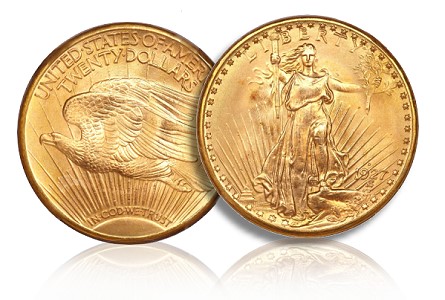By Mark Ferguson for CoinWeek – MFrarecoins.com
The coin market is at the leading edge of an emerging trend in coin grading and coin pricing. It started four years ago with the recognition of premium quality coins by CAC, Certified Acceptance Corporation. The founders of CAC recognized that coins just making a grade were dragging down the prices of coins of the same grade that almost make the next highest grade, often referred to as “premium quality” coins. And last year, PCGS and NGC followed suit by introducing their “+” grades, in a similar recognition of premium quality coins.
This trend is a true appreciation of pleasing “eye appeal” by experienced collectors and dealers. It’s diverting attention away from a focus on how much can the grades and values of coins be maximized to?…to seeing rare coins as beautiful objects of art. Of course, there are still unanswered questions about how this trend will continue to evolve. The safest thing to do to protect your investment in your collection is to convert your coins to “+” grading by NGC and PCGS and/or CAC verification. But to be really safe, you should consider CAC verification for all your coins, whether or not they have “+” grades.
 So far this trend has brought out the added price premiums for premium quality coins, and it’s convinced some collectors to stay away from buying coins that have not been graded with “+” grades or stickered by CAC. The driving question in this scenario is whether the coins that don’t qualify for CAC stickers or “+” grading will sustain their values. For sure, bargain hunters will be buying them. But will these coins, graded by PCGS and NGC that are average or below average for particular grades, be avoided by buyers, causing their values to erode substantially?
So far this trend has brought out the added price premiums for premium quality coins, and it’s convinced some collectors to stay away from buying coins that have not been graded with “+” grades or stickered by CAC. The driving question in this scenario is whether the coins that don’t qualify for CAC stickers or “+” grading will sustain their values. For sure, bargain hunters will be buying them. But will these coins, graded by PCGS and NGC that are average or below average for particular grades, be avoided by buyers, causing their values to erode substantially?
For now this is not likely, but it could occur over time. At this time there are not enough CAC stickered and “+” graded coins to satisfy demand. Not enough coins have been given the “PQ” designation. After all, CAC is not quite four years old, and PCGS and NGC have only been using “+” grading for a little more than a year. So people building collections have to wait a long time to find the coins they want that are designated as PQ, or they have to jump through some hoops to have coins regraded in attempts to get “+” grades, or to have them considered for CAC stickers. This involves time, cost, and risk.
Another element of this trend of recognizing premium quality coins is downgrading! Some people are actually having their coins downgraded so that they will qualify for “+” grades and/or CAC stickers. This includes major rarities, as well as more commonly encountered coins. For example, a 1927-D $20 St. Gaudens gold coin,( pictured above) the “King” of 20th Century gold coins, of which PCGS estimates there are just 15 to 18 known, was recently downgraded from a PCGS MS 66 to an NGC MS 65+ so it would qualify for a sticker by CAC. John Albanese, principal of CAC, said, “I’m finding that sophisticated collectors and investors do not want maxed out grades.” This coin sold at the Heritage Florida United Numismatists (F.U.N.) auction during January, 2010 for $1,495,000. CAC was involved in the latest private transaction of this rarity last month, paying in excess of $1.6 million.
Similarly, I was present a few years ago when two major trophy rarities, both of which set all time world record prices when they sold, were carefully removed from their grading service capsules and enclosed in new custom made holders. Three of us were present, and this was all done with much care taken to protect the coins. The owners believed that both coins were such well known, famous rarities, that it wouldn’t matter much what grades they were given by third-party grading services. They were thinking of the beauty and history of these two major rarities.
One more element of this trend of recognizing PQ coins, and those with attractive eye appeal, has been slowly taking shape for several years. This involves borderline uncirculated coins graded AU 58. These are coins that have just a touch of friction on their high points, taking them out of the uncirculated class. So far, price guides have not been recognizing this trend, but quite often AU 58 coins are more attractive looking that Mint State 60 and 61 coins that may be heavily bagged marked, or have other disfiguring blemishes, and they are often worth more money than MS 60 and 61 coins. Heavy silver dollars are a good example of how contact marks can mess up the look of uncirculated examples.
Sophisticated collectors are working with their dealer/agents to acquire coins that are unquestionably solid for their grades and of premium quality. They are taking the time to develop an understanding of how coins are graded, and what is appreciated by other collectors so that when the time comes to resell the coins they own, they stand the best chance of getting them sold to the right buyers who will pay commensurate prices.
Some collectors prefer either PCGS or NGC graded coins over the other for their own personal reasons, but CAC seems to be emerging as the overall preferred designation to have for PQ coins. This may be due to CAC being a separate brand that’s a third-party check and balance on PCGS and NGC. CAC has also been in operation longer than these two grading services have been offering “+” designations. But some people want both, a “+” grade by either PCGS or NGC and a CAC sticker.
This is a good time in the evolution of this grading and pricing trend to evaluate the coins in your collection for premium quality designations. If there are any coins that don’t meet the qualifications as PQ coins, it’s a good time to sell those and upgrade them while the market is still accepting non-PQ coins at reasonable prices. It’s possible that non-PQ coins graded by PCGS and NGC will go the way of coins graded by the lesser known third-party grading services – unwanted and lower priced. Now, price guides have a challenge to figure all this out. The PCGS price guide has made a deliberate effort to establish prices for PQ coins. This guide has the most prices listed for coins of premium quality. The NGC price guide is also addressing this issue. What will the other guides do?
 Mark Ferguson was a coin grader for PCGS , a market analyst for Coin Values and has been a coin dealer for more than 40 years. He has written for the ANA, Coin Dealer Newsletter, Coin World, Numismatic News, , Coin Values, The Numismatist and currently has a weekly column on CoinWeek. Mark can be reached at Mark Ferguson Rare Coins ( www.mfrarecoins.com)
Mark Ferguson was a coin grader for PCGS , a market analyst for Coin Values and has been a coin dealer for more than 40 years. He has written for the ANA, Coin Dealer Newsletter, Coin World, Numismatic News, , Coin Values, The Numismatist and currently has a weekly column on CoinWeek. Mark can be reached at Mark Ferguson Rare Coins ( www.mfrarecoins.com)




